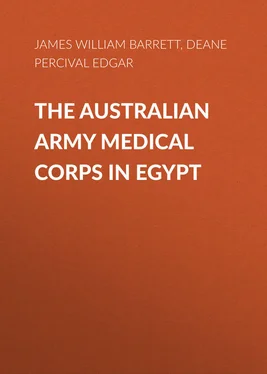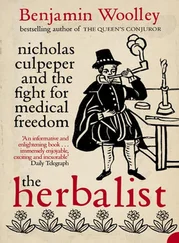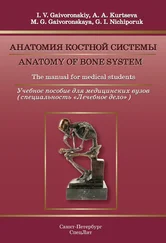Percival Deane - The Australian Army Medical Corps in Egypt
Здесь есть возможность читать онлайн «Percival Deane - The Australian Army Medical Corps in Egypt» — ознакомительный отрывок электронной книги совершенно бесплатно, а после прочтения отрывка купить полную версию. В некоторых случаях можно слушать аудио, скачать через торрент в формате fb2 и присутствует краткое содержание. ISBN: , Жанр: foreign_antique, foreign_prose, на английском языке. Описание произведения, (предисловие) а так же отзывы посетителей доступны на портале библиотеки ЛибКат.
- Название:The Australian Army Medical Corps in Egypt
- Автор:
- Жанр:
- Год:неизвестен
- ISBN:http://www.gutenberg.org/ebooks/41911
- Рейтинг книги:5 / 5. Голосов: 1
-
Избранное:Добавить в избранное
- Отзывы:
-
Ваша оценка:
- 100
- 1
- 2
- 3
- 4
- 5
The Australian Army Medical Corps in Egypt: краткое содержание, описание и аннотация
Предлагаем к чтению аннотацию, описание, краткое содержание или предисловие (зависит от того, что написал сам автор книги «The Australian Army Medical Corps in Egypt»). Если вы не нашли необходимую информацию о книге — напишите в комментариях, мы постараемся отыскать её.
The Australian Army Medical Corps in Egypt — читать онлайн ознакомительный отрывок
Ниже представлен текст книги, разбитый по страницам. Система сохранения места последней прочитанной страницы, позволяет с удобством читать онлайн бесплатно книгу «The Australian Army Medical Corps in Egypt», без необходимости каждый раз заново искать на чём Вы остановились. Поставьте закладку, и сможете в любой момент перейти на страницу, на которой закончили чтение.
Интервал:
Закладка:
When the Kyarra arrived in Egypt the British authorities did not possess any motor transport. There were some motor ambulances belonging to the New Zealand authorities and a few motor ambulances which accompanied the hospitals on the Kyarra , and which had been allotted to special units. It became obvious, however, that units might be placed in circumstances in which they did not require their ambulances, and others in circumstances in which they required more than their share; and accordingly Surgeon-General Williams decided to park the whole of these motor ambulances in two garages, a major one at Heliopolis and a smaller one at Ghezira, near No. 2 General Hospital. The garage at Heliopolis held at least thirty motor ambulances. It belonged to the Heliopolis Palace Hotel, and was equipped and furnished with a repairing plant at the expense of the Australian branch of the British Red Cross. The Ghezira garage was dealt with in like manner, and in addition the rent was paid in the first instance by the Australian branch of the British Red Cross. The organisation of these garages involved considerable difficulty. The drivers employed were not recruited by the Commonwealth Government as belonging to the motor transport, since there was not any motor ambulance establishment, and they consequently only received the ordinary private's pay. Furthermore promotions were very difficult to effect. Nevertheless they saved the position. For a long while Egypt was absolutely dependent on these motor fleets for the removal of the sick and wounded, British or Australian. The work was excessive but the drivers responded splendidly. Difficulties arose through different units endeavouring to commandeer motor ambulances for their own use. This was met by a decision of the D.M.S. Egypt that ambulances were to be kept in the garages, and telephoned for when necessary. From the outset, the lack of runabout motors was severely felt, and ambulances were frequently employed for purposes which would have been better effected by runabouts.
The end of April was reached. The bulk of the forces had disappeared from Egypt, and their position was only known by rumour; the hospital was gradually emptied of patients; Mena Camp had been abandoned, and Maadi Camp was reduced to small proportions. The weather was beautiful, and any one might have been easily lulled into a sense of false security. On April 28, however, a train-load of sick arrived. Its contents were not known until it arrived at the Heliopolis siding. The patients had come from Mudros, and numbered over 200 sick, including some 60 venereal cases, a matter of some interest in the light of subsequent events.
On the following day, however, without notice or warning of any description, wounded began to arrive in appalling numbers. On April 30 and May 1 and 2 no less than 1,352 cases were admitted at Heliopolis.
The expansion already indicated at Luna Park was at once effected, and some relief was obtained by transferring the lighter cases to Mena House – some seventeen miles distant. The last train-load of wounded arrived in the early morning of May 2, and deserves special notice, as many of the men were very seriously injured. There were about 100 cases; the train arrived at midnight, and was emptied by 4 o'clock in the morning. The bearing of the men badly injured was past praise. At 4 a.m. the main operating-room of the hospital bore eloquent testimony to the gravity of the work, which had been going on for many hours, and the exhausted condition of the staff further demonstrated what had occurred. The staff at the hospital was quite inadequate to cope with the rush, notwithstanding the willingness of every one concerned, and accordingly volunteers from some of the Field Ambulances, and from the Light Horse units which were still in Egypt, were called for and readily obtained. With the aid of the volunteers and by dint of universal devotion to duty the work was done, and on the whole done well.
The following table shows the staff available from April 2 to August 18, and the work required of it:
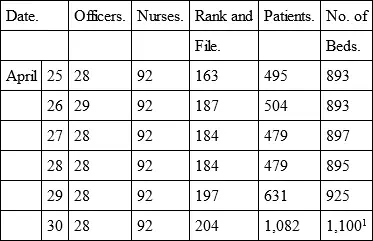
1 Including Luna Park.
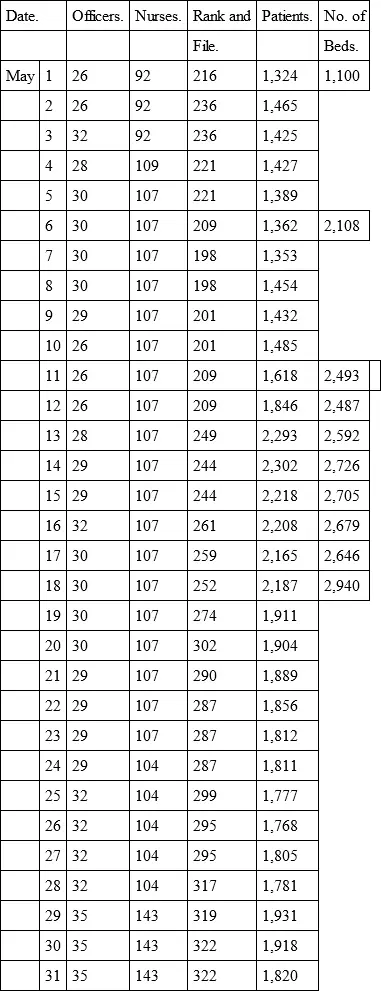
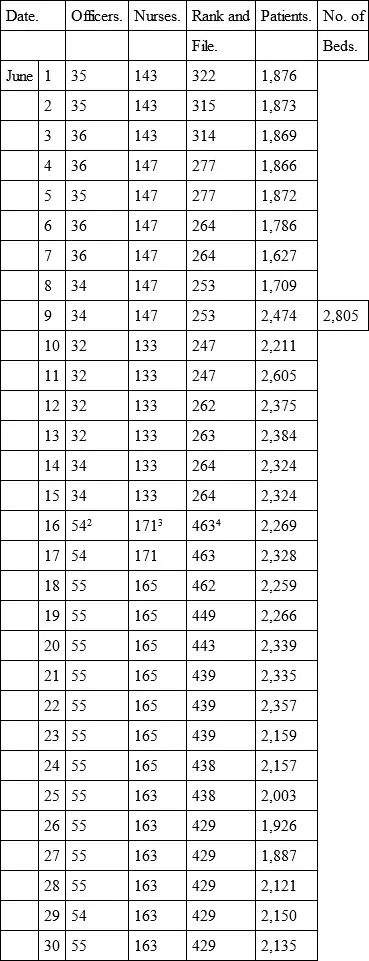
2 20 Reinforcements.
3 38 Reinforcements.
4 195 Reinforcements.


5 Auxiliaries separated and made independent.
The proceeding adopted on arrival of the train was as follows: Two officers were on duty on the platform in control of guard and stretcher squad. The officer in charge of the train handed in a list of the number of wounded on the train, classified into lying-down and sitting-up cases, those of gravity being specially marked. The train was then emptied carriage by carriage of the sitting-up patients, who walked to the hospital or were driven by the motor ambulances as the case might be, tally being kept at the door of the carriage. As soon as the train had been emptied of the sitting-up cases, the cot patients were removed by the stretcher squad to the motor ambulances, each of which carried a load of two patients. In serious cases an officer was sent with the patient, and as the distance was less than a quarter of a mile, the transfer was fairly rapid.
The Egyptian ambulance trains were on the whole good, and were equipped with necessaries and comforts by the Australian Branch British Red Cross. The Australian military authorities also provided nurses for the trains. The stretcher squads soon learned and did their work exceedingly well; but however well the work may be done, the removal of a gravely injured man from a mattress in a wooden bunk to a stretcher offers some difficulty and may cause distress. The construction of the wooden bunks left something to be desired. There is no doubt that it is desirable to devise a carriage of such a nature that stretchers can be inserted without difficulty under every patient, and his removal effected without disturbance.
The patients on arrival in the front hall of the hospital were provided with hot chocolate and biscuits, or with lime juice, and were at once drafted to various portions of the hospital. The lighter cases were sent to the auxiliary hospitals, and the more severe cases transferred to wards in the Palace building. Four sets of admitting medical officers with staffs were in readiness, and 200 patients could be disposed of in an hour. Promptitude was essential, as the trains sometimes followed on one another quickly. On admission the patients were bathed and given clean pyjamas. Their clothes and kit were sent to the Thresh Disinfector to be sterilised before being passed into the pack store.
Every patient on entering the hospital was provided with pyjamas, shirt, two handkerchiefs, socks, plate, knife, fork, spoon, mug, and slippers. The Red Cross Society provided him with writing-paper and envelopes, pencil, chocolate, nail brush, soap, cigarettes, tooth powder, and tooth brush.
Читать дальшеИнтервал:
Закладка:
Похожие книги на «The Australian Army Medical Corps in Egypt»
Представляем Вашему вниманию похожие книги на «The Australian Army Medical Corps in Egypt» списком для выбора. Мы отобрали схожую по названию и смыслу литературу в надежде предоставить читателям больше вариантов отыскать новые, интересные, ещё непрочитанные произведения.
Обсуждение, отзывы о книге «The Australian Army Medical Corps in Egypt» и просто собственные мнения читателей. Оставьте ваши комментарии, напишите, что Вы думаете о произведении, его смысле или главных героях. Укажите что конкретно понравилось, а что нет, и почему Вы так считаете.
